Cambridge, UK: A Study of Urban Tourism and its Local Impact
VerifiedAdded on 2024/05/16
|28
|5651
|441
Report
AI Summary
This report examines the impacts of urban tourism on the local community and culture in Cambridge, UK. It delves into the perspectives of residents regarding the effects of tourism, both positive and negative, on their lives and the existing cultural landscape. The research employs a mixed-methods approach, utilizing both qualitative and quantitative data collected from surveys conducted among local residents and case studies of prominent tourist locations like Great St Mary’s Church and the University of Cambridge. The study addresses research questions concerning residents' understanding of urban tourism, its impacts on the community, the pros and cons experienced by residents, and the changes in the existing culture due to tourism. The literature review covers the definition of urban tourism, demand and supply factors, current debates surrounding urbanization, and the characteristics of Cambridge as a tourist-historic city. The findings and discussion sections present the data collected and analyze the various impacts of tourism on Cambridge, including economic, social, and environmental aspects.
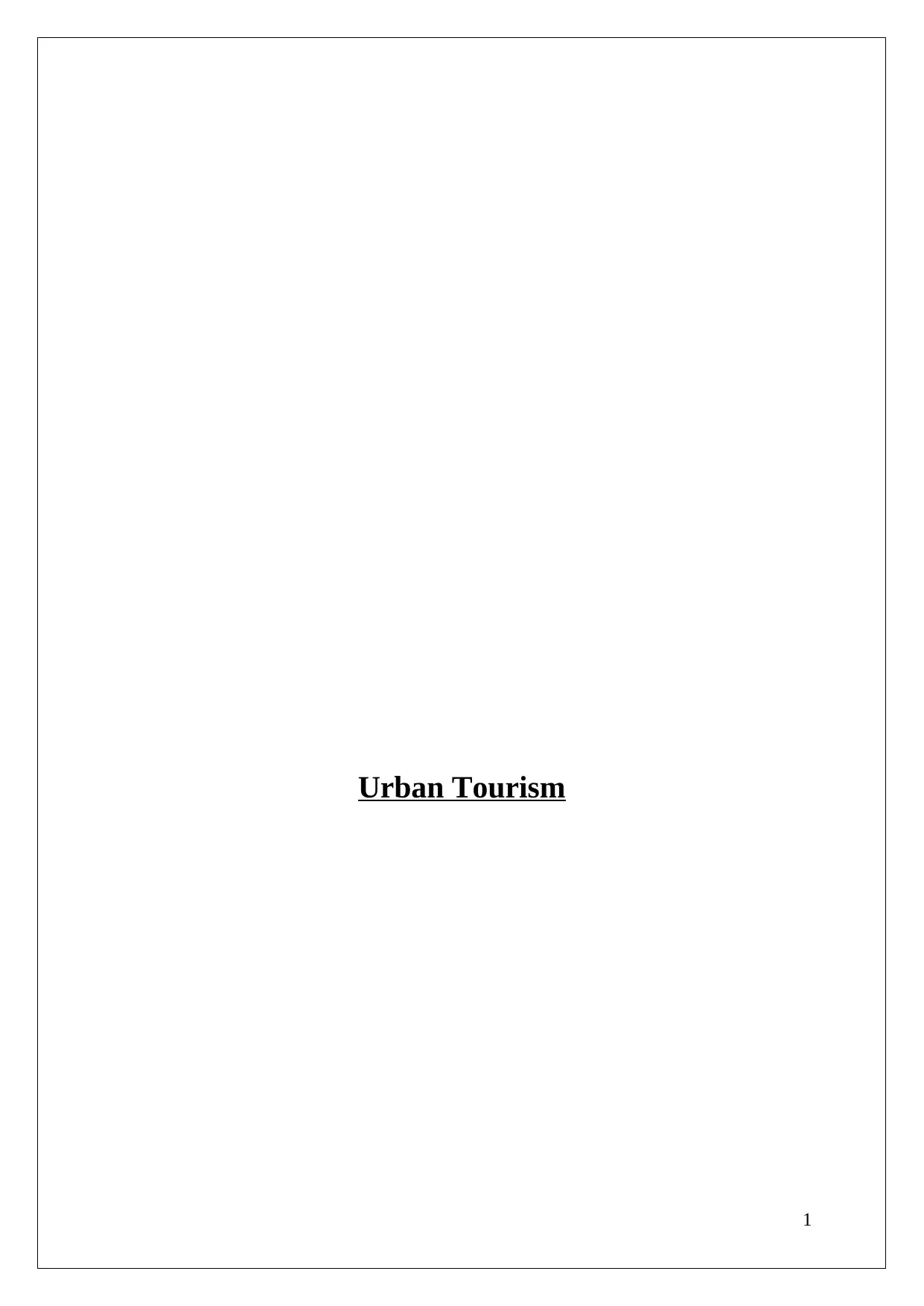
Urban Tourism
1
1
Paraphrase This Document
Need a fresh take? Get an instant paraphrase of this document with our AI Paraphraser
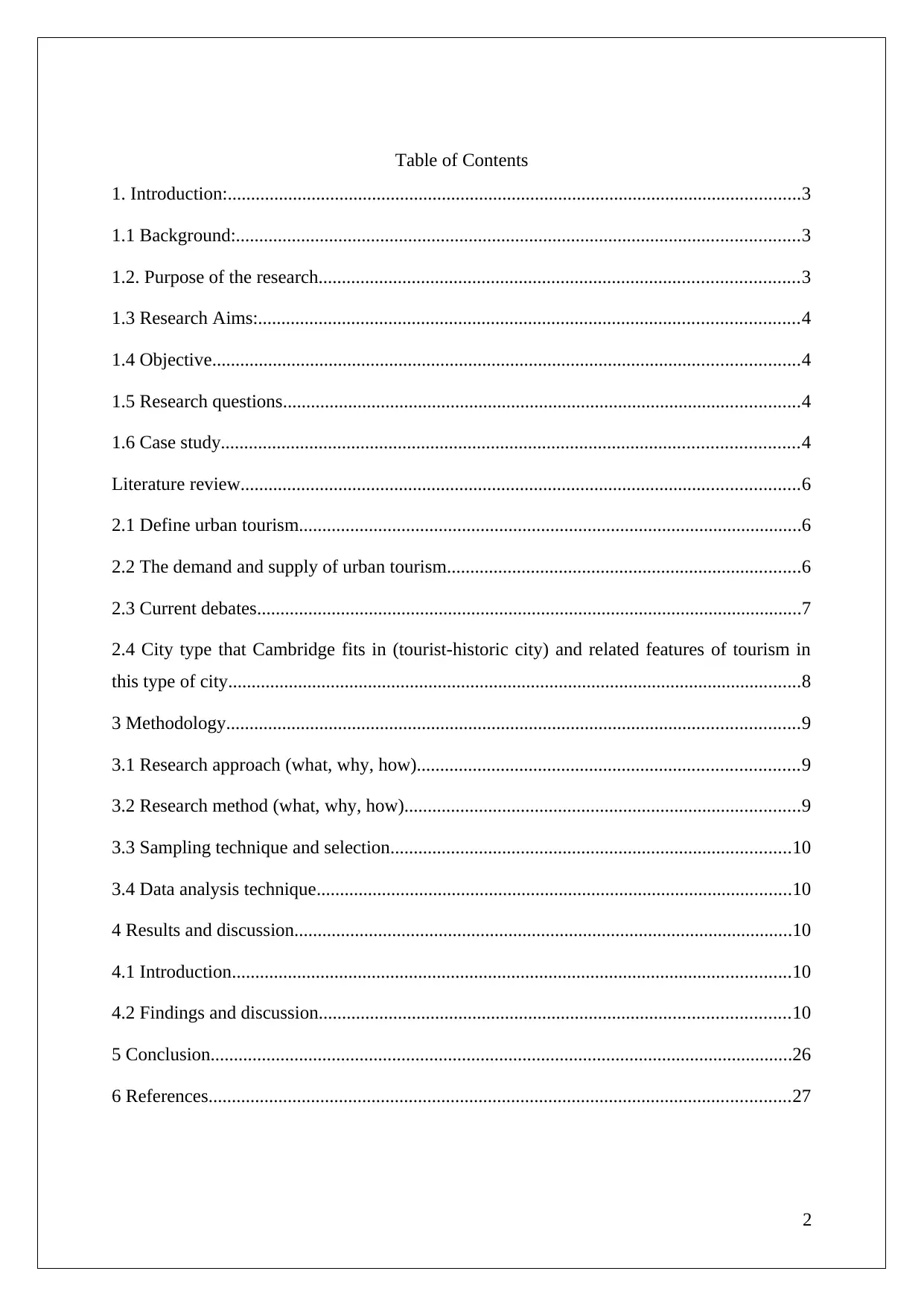
Table of Contents
1. Introduction:...........................................................................................................................3
1.1 Background:.........................................................................................................................3
1.2. Purpose of the research.......................................................................................................3
1.3 Research Aims:....................................................................................................................4
1.4 Objective..............................................................................................................................4
1.5 Research questions...............................................................................................................4
1.6 Case study............................................................................................................................4
Literature review........................................................................................................................6
2.1 Define urban tourism............................................................................................................6
2.2 The demand and supply of urban tourism............................................................................6
2.3 Current debates.....................................................................................................................7
2.4 City type that Cambridge fits in (tourist-historic city) and related features of tourism in
this type of city...........................................................................................................................8
3 Methodology...........................................................................................................................9
3.1 Research approach (what, why, how)..................................................................................9
3.2 Research method (what, why, how).....................................................................................9
3.3 Sampling technique and selection......................................................................................10
3.4 Data analysis technique......................................................................................................10
4 Results and discussion...........................................................................................................10
4.1 Introduction........................................................................................................................10
4.2 Findings and discussion.....................................................................................................10
5 Conclusion.............................................................................................................................26
6 References.............................................................................................................................27
2
1. Introduction:...........................................................................................................................3
1.1 Background:.........................................................................................................................3
1.2. Purpose of the research.......................................................................................................3
1.3 Research Aims:....................................................................................................................4
1.4 Objective..............................................................................................................................4
1.5 Research questions...............................................................................................................4
1.6 Case study............................................................................................................................4
Literature review........................................................................................................................6
2.1 Define urban tourism............................................................................................................6
2.2 The demand and supply of urban tourism............................................................................6
2.3 Current debates.....................................................................................................................7
2.4 City type that Cambridge fits in (tourist-historic city) and related features of tourism in
this type of city...........................................................................................................................8
3 Methodology...........................................................................................................................9
3.1 Research approach (what, why, how)..................................................................................9
3.2 Research method (what, why, how).....................................................................................9
3.3 Sampling technique and selection......................................................................................10
3.4 Data analysis technique......................................................................................................10
4 Results and discussion...........................................................................................................10
4.1 Introduction........................................................................................................................10
4.2 Findings and discussion.....................................................................................................10
5 Conclusion.............................................................................................................................26
6 References.............................................................................................................................27
2
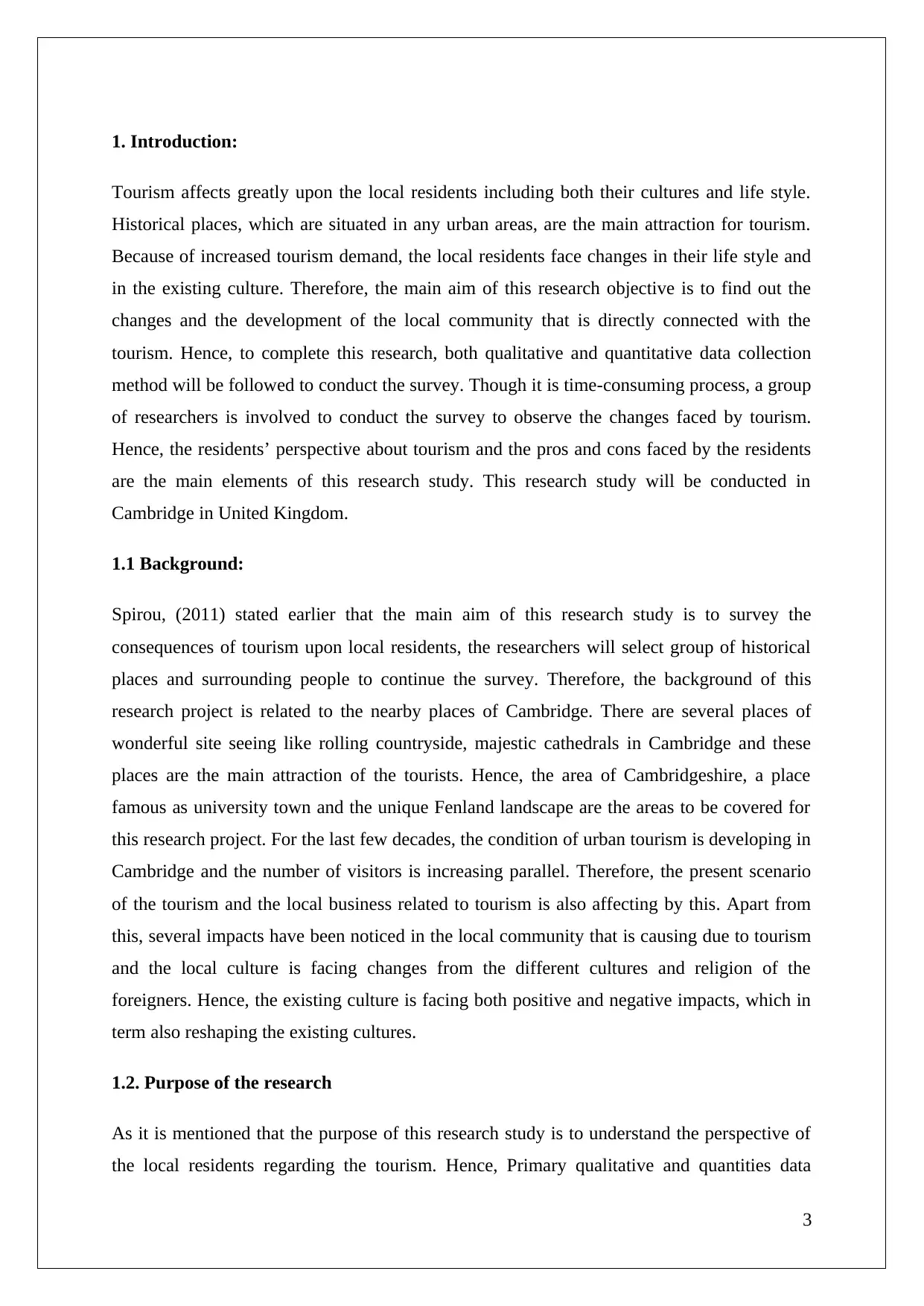
1. Introduction:
Tourism affects greatly upon the local residents including both their cultures and life style.
Historical places, which are situated in any urban areas, are the main attraction for tourism.
Because of increased tourism demand, the local residents face changes in their life style and
in the existing culture. Therefore, the main aim of this research objective is to find out the
changes and the development of the local community that is directly connected with the
tourism. Hence, to complete this research, both qualitative and quantitative data collection
method will be followed to conduct the survey. Though it is time-consuming process, a group
of researchers is involved to conduct the survey to observe the changes faced by tourism.
Hence, the residents’ perspective about tourism and the pros and cons faced by the residents
are the main elements of this research study. This research study will be conducted in
Cambridge in United Kingdom.
1.1 Background:
Spirou, (2011) stated earlier that the main aim of this research study is to survey the
consequences of tourism upon local residents, the researchers will select group of historical
places and surrounding people to continue the survey. Therefore, the background of this
research project is related to the nearby places of Cambridge. There are several places of
wonderful site seeing like rolling countryside, majestic cathedrals in Cambridge and these
places are the main attraction of the tourists. Hence, the area of Cambridgeshire, a place
famous as university town and the unique Fenland landscape are the areas to be covered for
this research project. For the last few decades, the condition of urban tourism is developing in
Cambridge and the number of visitors is increasing parallel. Therefore, the present scenario
of the tourism and the local business related to tourism is also affecting by this. Apart from
this, several impacts have been noticed in the local community that is causing due to tourism
and the local culture is facing changes from the different cultures and religion of the
foreigners. Hence, the existing culture is facing both positive and negative impacts, which in
term also reshaping the existing cultures.
1.2. Purpose of the research
As it is mentioned that the purpose of this research study is to understand the perspective of
the local residents regarding the tourism. Hence, Primary qualitative and quantities data
3
Tourism affects greatly upon the local residents including both their cultures and life style.
Historical places, which are situated in any urban areas, are the main attraction for tourism.
Because of increased tourism demand, the local residents face changes in their life style and
in the existing culture. Therefore, the main aim of this research objective is to find out the
changes and the development of the local community that is directly connected with the
tourism. Hence, to complete this research, both qualitative and quantitative data collection
method will be followed to conduct the survey. Though it is time-consuming process, a group
of researchers is involved to conduct the survey to observe the changes faced by tourism.
Hence, the residents’ perspective about tourism and the pros and cons faced by the residents
are the main elements of this research study. This research study will be conducted in
Cambridge in United Kingdom.
1.1 Background:
Spirou, (2011) stated earlier that the main aim of this research study is to survey the
consequences of tourism upon local residents, the researchers will select group of historical
places and surrounding people to continue the survey. Therefore, the background of this
research project is related to the nearby places of Cambridge. There are several places of
wonderful site seeing like rolling countryside, majestic cathedrals in Cambridge and these
places are the main attraction of the tourists. Hence, the area of Cambridgeshire, a place
famous as university town and the unique Fenland landscape are the areas to be covered for
this research project. For the last few decades, the condition of urban tourism is developing in
Cambridge and the number of visitors is increasing parallel. Therefore, the present scenario
of the tourism and the local business related to tourism is also affecting by this. Apart from
this, several impacts have been noticed in the local community that is causing due to tourism
and the local culture is facing changes from the different cultures and religion of the
foreigners. Hence, the existing culture is facing both positive and negative impacts, which in
term also reshaping the existing cultures.
1.2. Purpose of the research
As it is mentioned that the purpose of this research study is to understand the perspective of
the local residents regarding the tourism. Hence, Primary qualitative and quantities data
3
⊘ This is a preview!⊘
Do you want full access?
Subscribe today to unlock all pages.

Trusted by 1+ million students worldwide
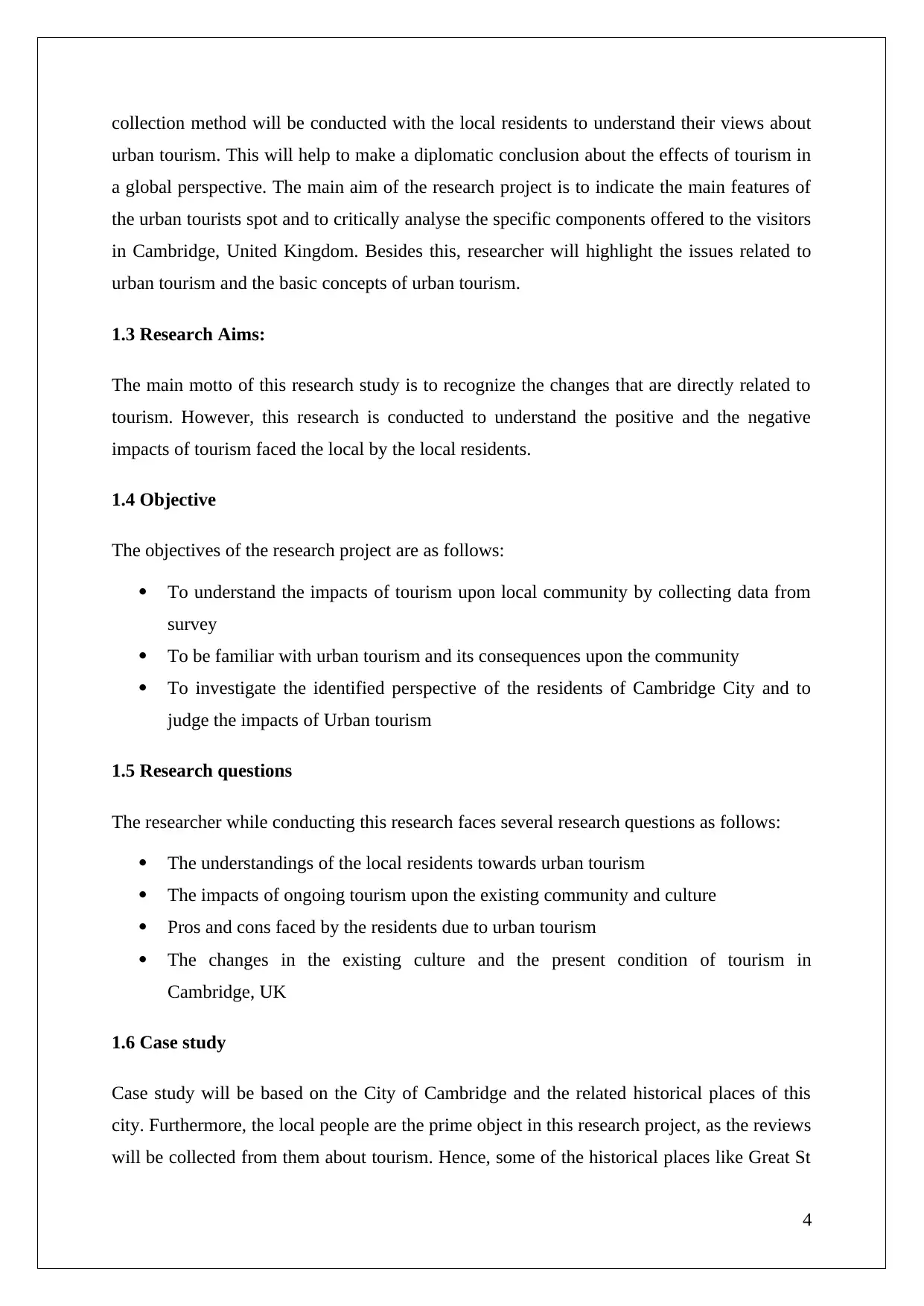
collection method will be conducted with the local residents to understand their views about
urban tourism. This will help to make a diplomatic conclusion about the effects of tourism in
a global perspective. The main aim of the research project is to indicate the main features of
the urban tourists spot and to critically analyse the specific components offered to the visitors
in Cambridge, United Kingdom. Besides this, researcher will highlight the issues related to
urban tourism and the basic concepts of urban tourism.
1.3 Research Aims:
The main motto of this research study is to recognize the changes that are directly related to
tourism. However, this research is conducted to understand the positive and the negative
impacts of tourism faced the local by the local residents.
1.4 Objective
The objectives of the research project are as follows:
To understand the impacts of tourism upon local community by collecting data from
survey
To be familiar with urban tourism and its consequences upon the community
To investigate the identified perspective of the residents of Cambridge City and to
judge the impacts of Urban tourism
1.5 Research questions
The researcher while conducting this research faces several research questions as follows:
The understandings of the local residents towards urban tourism
The impacts of ongoing tourism upon the existing community and culture
Pros and cons faced by the residents due to urban tourism
The changes in the existing culture and the present condition of tourism in
Cambridge, UK
1.6 Case study
Case study will be based on the City of Cambridge and the related historical places of this
city. Furthermore, the local people are the prime object in this research project, as the reviews
will be collected from them about tourism. Hence, some of the historical places like Great St
4
urban tourism. This will help to make a diplomatic conclusion about the effects of tourism in
a global perspective. The main aim of the research project is to indicate the main features of
the urban tourists spot and to critically analyse the specific components offered to the visitors
in Cambridge, United Kingdom. Besides this, researcher will highlight the issues related to
urban tourism and the basic concepts of urban tourism.
1.3 Research Aims:
The main motto of this research study is to recognize the changes that are directly related to
tourism. However, this research is conducted to understand the positive and the negative
impacts of tourism faced the local by the local residents.
1.4 Objective
The objectives of the research project are as follows:
To understand the impacts of tourism upon local community by collecting data from
survey
To be familiar with urban tourism and its consequences upon the community
To investigate the identified perspective of the residents of Cambridge City and to
judge the impacts of Urban tourism
1.5 Research questions
The researcher while conducting this research faces several research questions as follows:
The understandings of the local residents towards urban tourism
The impacts of ongoing tourism upon the existing community and culture
Pros and cons faced by the residents due to urban tourism
The changes in the existing culture and the present condition of tourism in
Cambridge, UK
1.6 Case study
Case study will be based on the City of Cambridge and the related historical places of this
city. Furthermore, the local people are the prime object in this research project, as the reviews
will be collected from them about tourism. Hence, some of the historical places like Great St
4
Paraphrase This Document
Need a fresh take? Get an instant paraphrase of this document with our AI Paraphraser
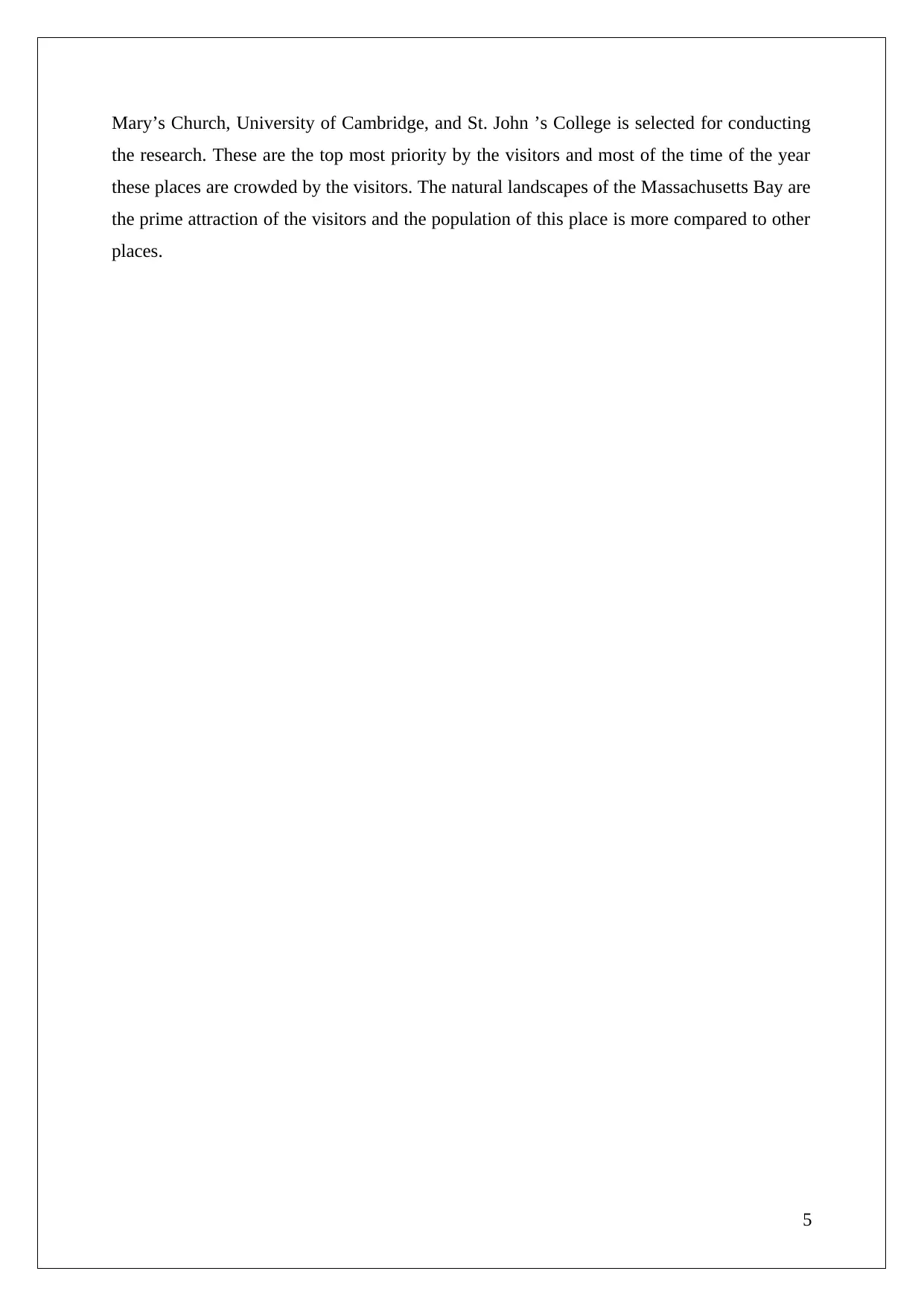
Mary’s Church, University of Cambridge, and St. John ’s College is selected for conducting
the research. These are the top most priority by the visitors and most of the time of the year
these places are crowded by the visitors. The natural landscapes of the Massachusetts Bay are
the prime attraction of the visitors and the population of this place is more compared to other
places.
5
the research. These are the top most priority by the visitors and most of the time of the year
these places are crowded by the visitors. The natural landscapes of the Massachusetts Bay are
the prime attraction of the visitors and the population of this place is more compared to other
places.
5
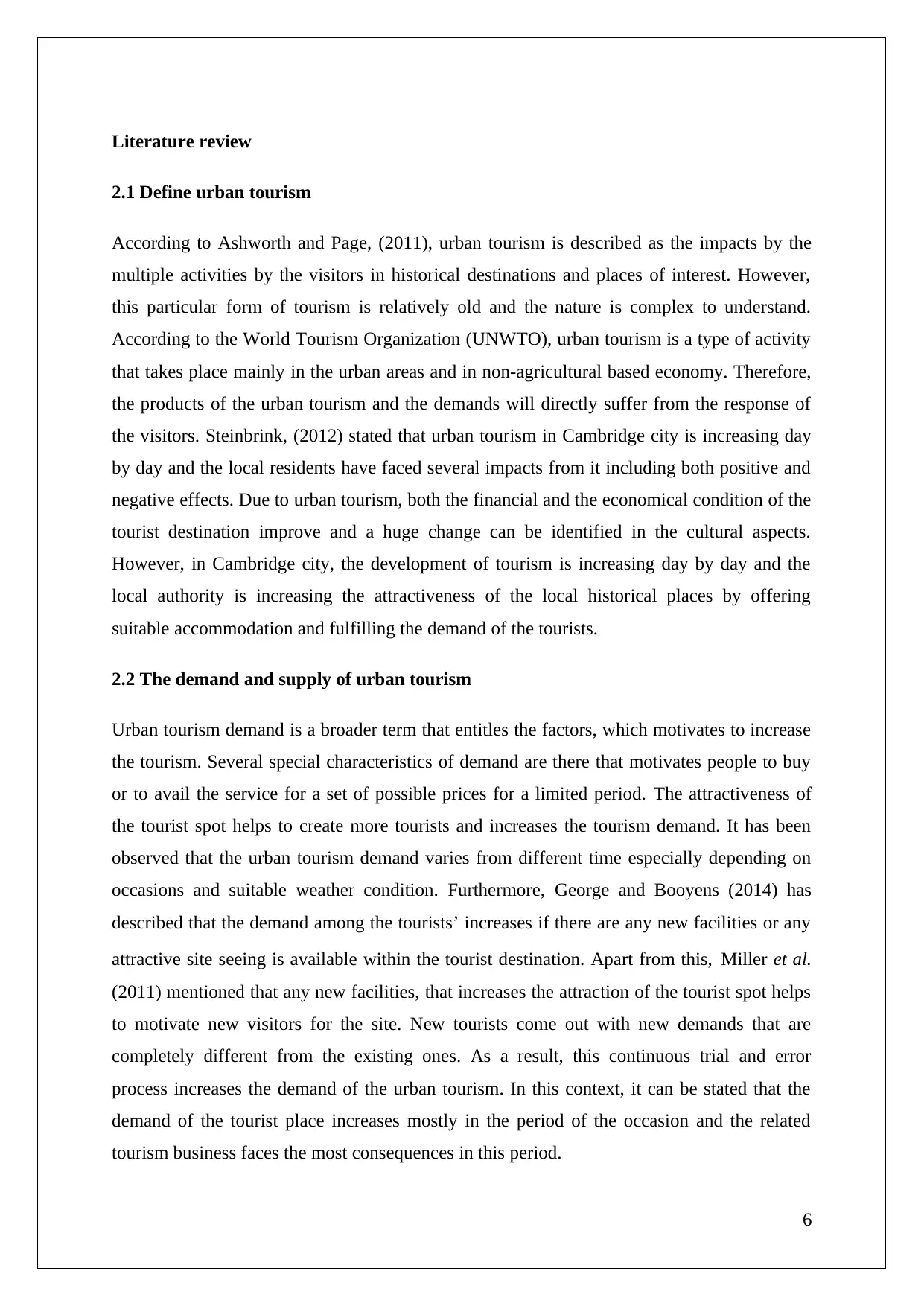
Literature review
2.1 Define urban tourism
According to Ashworth and Page, (2011), urban tourism is described as the impacts by the
multiple activities by the visitors in historical destinations and places of interest. However,
this particular form of tourism is relatively old and the nature is complex to understand.
According to the World Tourism Organization (UNWTO), urban tourism is a type of activity
that takes place mainly in the urban areas and in non-agricultural based economy. Therefore,
the products of the urban tourism and the demands will directly suffer from the response of
the visitors. Steinbrink, (2012) stated that urban tourism in Cambridge city is increasing day
by day and the local residents have faced several impacts from it including both positive and
negative effects. Due to urban tourism, both the financial and the economical condition of the
tourist destination improve and a huge change can be identified in the cultural aspects.
However, in Cambridge city, the development of tourism is increasing day by day and the
local authority is increasing the attractiveness of the local historical places by offering
suitable accommodation and fulfilling the demand of the tourists.
2.2 The demand and supply of urban tourism
Urban tourism demand is a broader term that entitles the factors, which motivates to increase
the tourism. Several special characteristics of demand are there that motivates people to buy
or to avail the service for a set of possible prices for a limited period. The attractiveness of
the tourist spot helps to create more tourists and increases the tourism demand. It has been
observed that the urban tourism demand varies from different time especially depending on
occasions and suitable weather condition. Furthermore, George and Booyens (2014) has
described that the demand among the tourists’ increases if there are any new facilities or any
attractive site seeing is available within the tourist destination. Apart from this, Miller et al.
(2011) mentioned that any new facilities, that increases the attraction of the tourist spot helps
to motivate new visitors for the site. New tourists come out with new demands that are
completely different from the existing ones. As a result, this continuous trial and error
process increases the demand of the urban tourism. In this context, it can be stated that the
demand of the tourist place increases mostly in the period of the occasion and the related
tourism business faces the most consequences in this period.
6
2.1 Define urban tourism
According to Ashworth and Page, (2011), urban tourism is described as the impacts by the
multiple activities by the visitors in historical destinations and places of interest. However,
this particular form of tourism is relatively old and the nature is complex to understand.
According to the World Tourism Organization (UNWTO), urban tourism is a type of activity
that takes place mainly in the urban areas and in non-agricultural based economy. Therefore,
the products of the urban tourism and the demands will directly suffer from the response of
the visitors. Steinbrink, (2012) stated that urban tourism in Cambridge city is increasing day
by day and the local residents have faced several impacts from it including both positive and
negative effects. Due to urban tourism, both the financial and the economical condition of the
tourist destination improve and a huge change can be identified in the cultural aspects.
However, in Cambridge city, the development of tourism is increasing day by day and the
local authority is increasing the attractiveness of the local historical places by offering
suitable accommodation and fulfilling the demand of the tourists.
2.2 The demand and supply of urban tourism
Urban tourism demand is a broader term that entitles the factors, which motivates to increase
the tourism. Several special characteristics of demand are there that motivates people to buy
or to avail the service for a set of possible prices for a limited period. The attractiveness of
the tourist spot helps to create more tourists and increases the tourism demand. It has been
observed that the urban tourism demand varies from different time especially depending on
occasions and suitable weather condition. Furthermore, George and Booyens (2014) has
described that the demand among the tourists’ increases if there are any new facilities or any
attractive site seeing is available within the tourist destination. Apart from this, Miller et al.
(2011) mentioned that any new facilities, that increases the attraction of the tourist spot helps
to motivate new visitors for the site. New tourists come out with new demands that are
completely different from the existing ones. As a result, this continuous trial and error
process increases the demand of the urban tourism. In this context, it can be stated that the
demand of the tourist place increases mostly in the period of the occasion and the related
tourism business faces the most consequences in this period.
6
⊘ This is a preview!⊘
Do you want full access?
Subscribe today to unlock all pages.

Trusted by 1+ million students worldwide
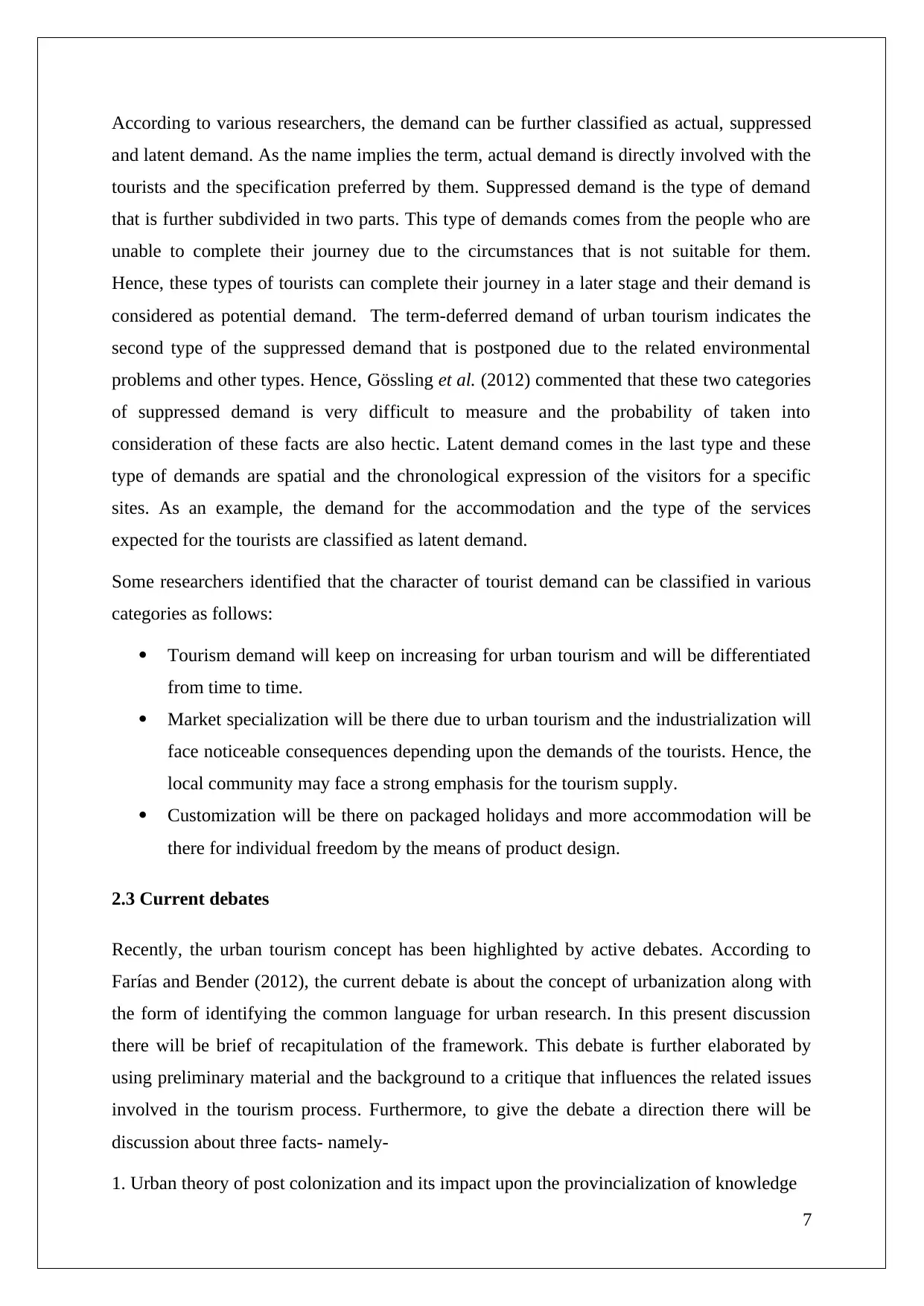
According to various researchers, the demand can be further classified as actual, suppressed
and latent demand. As the name implies the term, actual demand is directly involved with the
tourists and the specification preferred by them. Suppressed demand is the type of demand
that is further subdivided in two parts. This type of demands comes from the people who are
unable to complete their journey due to the circumstances that is not suitable for them.
Hence, these types of tourists can complete their journey in a later stage and their demand is
considered as potential demand. The term-deferred demand of urban tourism indicates the
second type of the suppressed demand that is postponed due to the related environmental
problems and other types. Hence, Gössling et al. (2012) commented that these two categories
of suppressed demand is very difficult to measure and the probability of taken into
consideration of these facts are also hectic. Latent demand comes in the last type and these
type of demands are spatial and the chronological expression of the visitors for a specific
sites. As an example, the demand for the accommodation and the type of the services
expected for the tourists are classified as latent demand.
Some researchers identified that the character of tourist demand can be classified in various
categories as follows:
Tourism demand will keep on increasing for urban tourism and will be differentiated
from time to time.
Market specialization will be there due to urban tourism and the industrialization will
face noticeable consequences depending upon the demands of the tourists. Hence, the
local community may face a strong emphasis for the tourism supply.
Customization will be there on packaged holidays and more accommodation will be
there for individual freedom by the means of product design.
2.3 Current debates
Recently, the urban tourism concept has been highlighted by active debates. According to
Farías and Bender (2012), the current debate is about the concept of urbanization along with
the form of identifying the common language for urban research. In this present discussion
there will be brief of recapitulation of the framework. This debate is further elaborated by
using preliminary material and the background to a critique that influences the related issues
involved in the tourism process. Furthermore, to give the debate a direction there will be
discussion about three facts- namely-
1. Urban theory of post colonization and its impact upon the provincialization of knowledge
7
and latent demand. As the name implies the term, actual demand is directly involved with the
tourists and the specification preferred by them. Suppressed demand is the type of demand
that is further subdivided in two parts. This type of demands comes from the people who are
unable to complete their journey due to the circumstances that is not suitable for them.
Hence, these types of tourists can complete their journey in a later stage and their demand is
considered as potential demand. The term-deferred demand of urban tourism indicates the
second type of the suppressed demand that is postponed due to the related environmental
problems and other types. Hence, Gössling et al. (2012) commented that these two categories
of suppressed demand is very difficult to measure and the probability of taken into
consideration of these facts are also hectic. Latent demand comes in the last type and these
type of demands are spatial and the chronological expression of the visitors for a specific
sites. As an example, the demand for the accommodation and the type of the services
expected for the tourists are classified as latent demand.
Some researchers identified that the character of tourist demand can be classified in various
categories as follows:
Tourism demand will keep on increasing for urban tourism and will be differentiated
from time to time.
Market specialization will be there due to urban tourism and the industrialization will
face noticeable consequences depending upon the demands of the tourists. Hence, the
local community may face a strong emphasis for the tourism supply.
Customization will be there on packaged holidays and more accommodation will be
there for individual freedom by the means of product design.
2.3 Current debates
Recently, the urban tourism concept has been highlighted by active debates. According to
Farías and Bender (2012), the current debate is about the concept of urbanization along with
the form of identifying the common language for urban research. In this present discussion
there will be brief of recapitulation of the framework. This debate is further elaborated by
using preliminary material and the background to a critique that influences the related issues
involved in the tourism process. Furthermore, to give the debate a direction there will be
discussion about three facts- namely-
1. Urban theory of post colonization and its impact upon the provincialization of knowledge
7
Paraphrase This Document
Need a fresh take? Get an instant paraphrase of this document with our AI Paraphraser
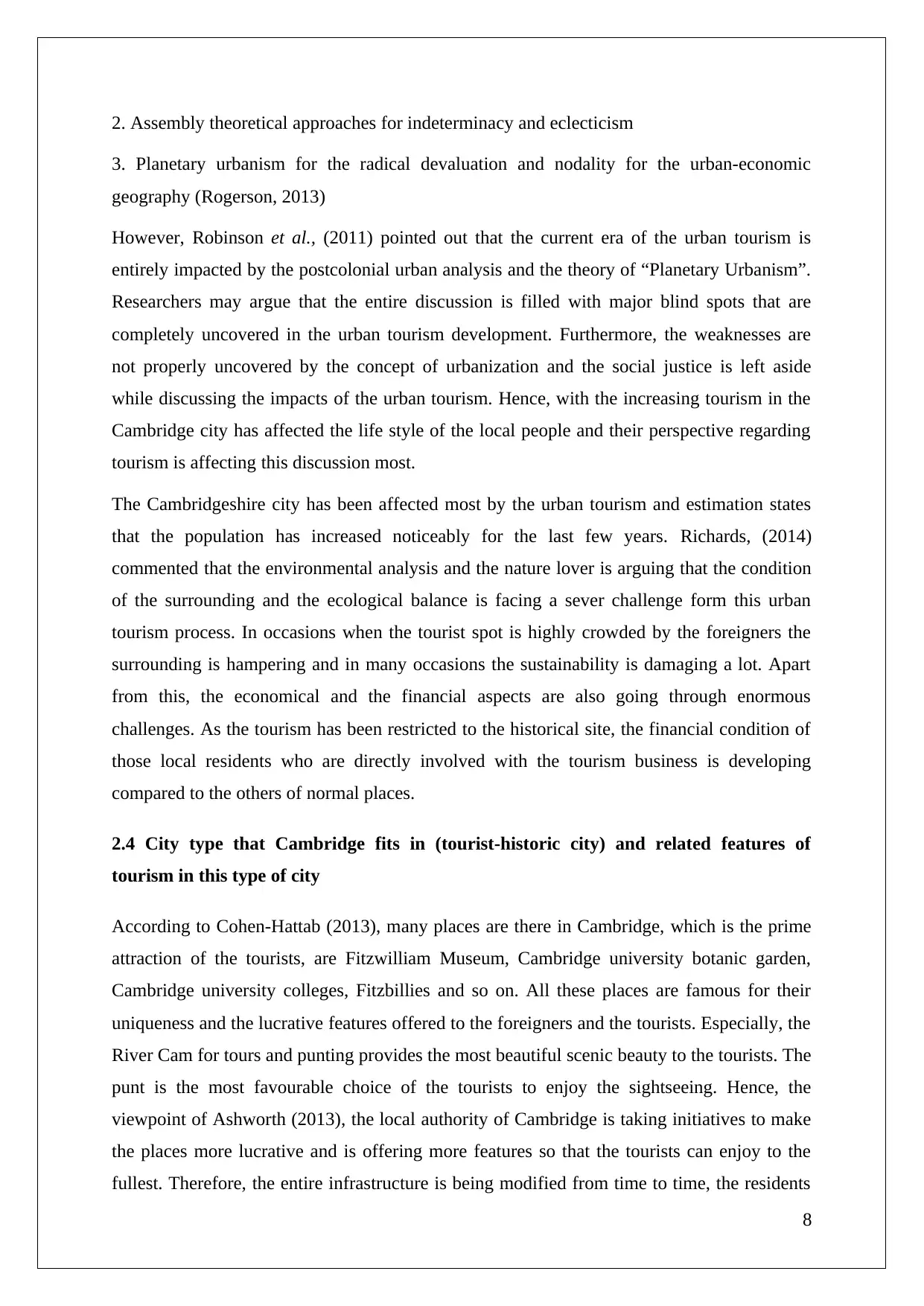
2. Assembly theoretical approaches for indeterminacy and eclecticism
3. Planetary urbanism for the radical devaluation and nodality for the urban-economic
geography (Rogerson, 2013)
However, Robinson et al., (2011) pointed out that the current era of the urban tourism is
entirely impacted by the postcolonial urban analysis and the theory of “Planetary Urbanism”.
Researchers may argue that the entire discussion is filled with major blind spots that are
completely uncovered in the urban tourism development. Furthermore, the weaknesses are
not properly uncovered by the concept of urbanization and the social justice is left aside
while discussing the impacts of the urban tourism. Hence, with the increasing tourism in the
Cambridge city has affected the life style of the local people and their perspective regarding
tourism is affecting this discussion most.
The Cambridgeshire city has been affected most by the urban tourism and estimation states
that the population has increased noticeably for the last few years. Richards, (2014)
commented that the environmental analysis and the nature lover is arguing that the condition
of the surrounding and the ecological balance is facing a sever challenge form this urban
tourism process. In occasions when the tourist spot is highly crowded by the foreigners the
surrounding is hampering and in many occasions the sustainability is damaging a lot. Apart
from this, the economical and the financial aspects are also going through enormous
challenges. As the tourism has been restricted to the historical site, the financial condition of
those local residents who are directly involved with the tourism business is developing
compared to the others of normal places.
2.4 City type that Cambridge fits in (tourist-historic city) and related features of
tourism in this type of city
According to Cohen-Hattab (2013), many places are there in Cambridge, which is the prime
attraction of the tourists, are Fitzwilliam Museum, Cambridge university botanic garden,
Cambridge university colleges, Fitzbillies and so on. All these places are famous for their
uniqueness and the lucrative features offered to the foreigners and the tourists. Especially, the
River Cam for tours and punting provides the most beautiful scenic beauty to the tourists. The
punt is the most favourable choice of the tourists to enjoy the sightseeing. Hence, the
viewpoint of Ashworth (2013), the local authority of Cambridge is taking initiatives to make
the places more lucrative and is offering more features so that the tourists can enjoy to the
fullest. Therefore, the entire infrastructure is being modified from time to time, the residents
8
3. Planetary urbanism for the radical devaluation and nodality for the urban-economic
geography (Rogerson, 2013)
However, Robinson et al., (2011) pointed out that the current era of the urban tourism is
entirely impacted by the postcolonial urban analysis and the theory of “Planetary Urbanism”.
Researchers may argue that the entire discussion is filled with major blind spots that are
completely uncovered in the urban tourism development. Furthermore, the weaknesses are
not properly uncovered by the concept of urbanization and the social justice is left aside
while discussing the impacts of the urban tourism. Hence, with the increasing tourism in the
Cambridge city has affected the life style of the local people and their perspective regarding
tourism is affecting this discussion most.
The Cambridgeshire city has been affected most by the urban tourism and estimation states
that the population has increased noticeably for the last few years. Richards, (2014)
commented that the environmental analysis and the nature lover is arguing that the condition
of the surrounding and the ecological balance is facing a sever challenge form this urban
tourism process. In occasions when the tourist spot is highly crowded by the foreigners the
surrounding is hampering and in many occasions the sustainability is damaging a lot. Apart
from this, the economical and the financial aspects are also going through enormous
challenges. As the tourism has been restricted to the historical site, the financial condition of
those local residents who are directly involved with the tourism business is developing
compared to the others of normal places.
2.4 City type that Cambridge fits in (tourist-historic city) and related features of
tourism in this type of city
According to Cohen-Hattab (2013), many places are there in Cambridge, which is the prime
attraction of the tourists, are Fitzwilliam Museum, Cambridge university botanic garden,
Cambridge university colleges, Fitzbillies and so on. All these places are famous for their
uniqueness and the lucrative features offered to the foreigners and the tourists. Especially, the
River Cam for tours and punting provides the most beautiful scenic beauty to the tourists. The
punt is the most favourable choice of the tourists to enjoy the sightseeing. Hence, the
viewpoint of Ashworth (2013), the local authority of Cambridge is taking initiatives to make
the places more lucrative and is offering more features so that the tourists can enjoy to the
fullest. Therefore, the entire infrastructure is being modified from time to time, the residents
8
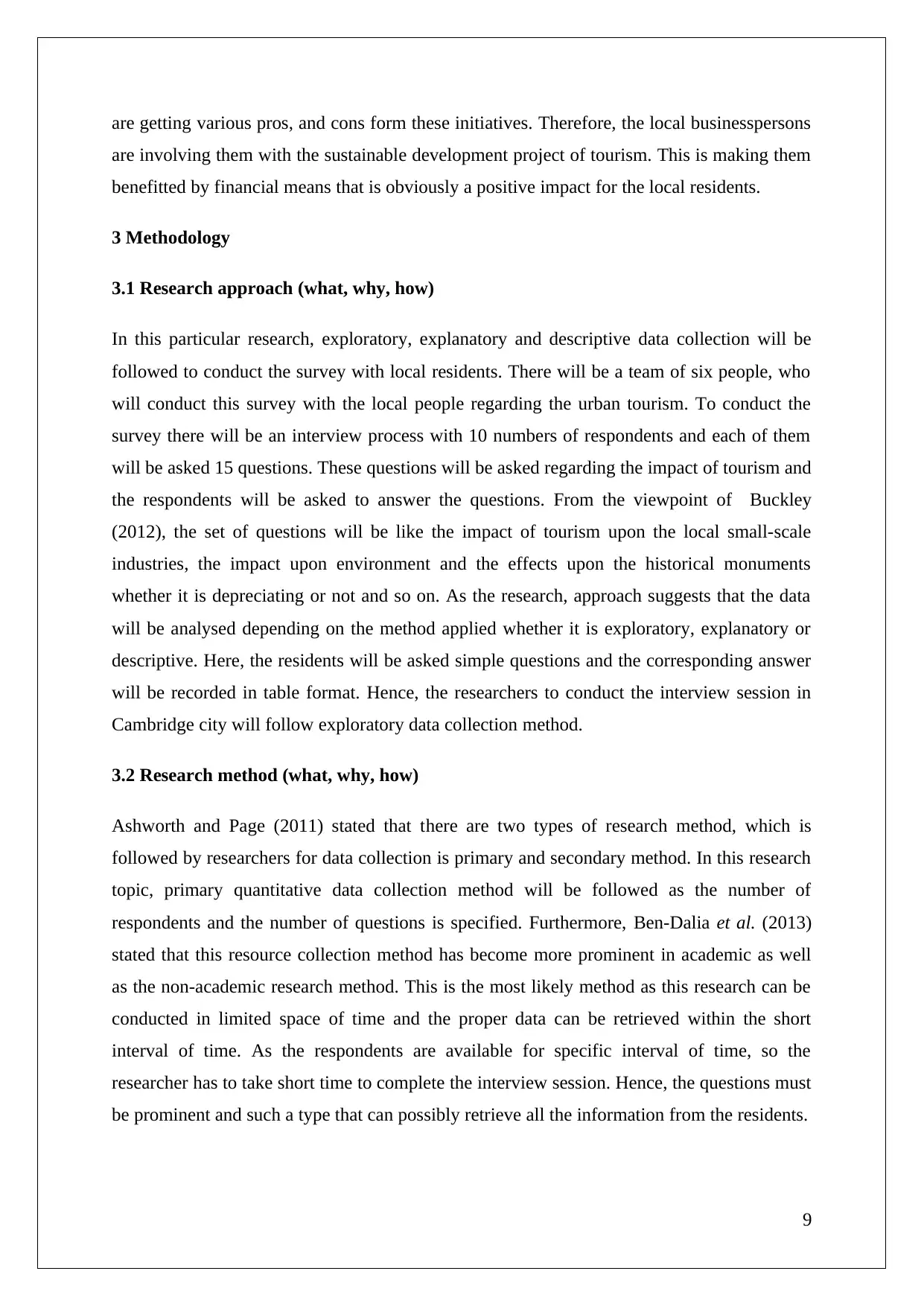
are getting various pros, and cons form these initiatives. Therefore, the local businesspersons
are involving them with the sustainable development project of tourism. This is making them
benefitted by financial means that is obviously a positive impact for the local residents.
3 Methodology
3.1 Research approach (what, why, how)
In this particular research, exploratory, explanatory and descriptive data collection will be
followed to conduct the survey with local residents. There will be a team of six people, who
will conduct this survey with the local people regarding the urban tourism. To conduct the
survey there will be an interview process with 10 numbers of respondents and each of them
will be asked 15 questions. These questions will be asked regarding the impact of tourism and
the respondents will be asked to answer the questions. From the viewpoint of Buckley
(2012), the set of questions will be like the impact of tourism upon the local small-scale
industries, the impact upon environment and the effects upon the historical monuments
whether it is depreciating or not and so on. As the research, approach suggests that the data
will be analysed depending on the method applied whether it is exploratory, explanatory or
descriptive. Here, the residents will be asked simple questions and the corresponding answer
will be recorded in table format. Hence, the researchers to conduct the interview session in
Cambridge city will follow exploratory data collection method.
3.2 Research method (what, why, how)
Ashworth and Page (2011) stated that there are two types of research method, which is
followed by researchers for data collection is primary and secondary method. In this research
topic, primary quantitative data collection method will be followed as the number of
respondents and the number of questions is specified. Furthermore, Ben-Dalia et al. (2013)
stated that this resource collection method has become more prominent in academic as well
as the non-academic research method. This is the most likely method as this research can be
conducted in limited space of time and the proper data can be retrieved within the short
interval of time. As the respondents are available for specific interval of time, so the
researcher has to take short time to complete the interview session. Hence, the questions must
be prominent and such a type that can possibly retrieve all the information from the residents.
9
are involving them with the sustainable development project of tourism. This is making them
benefitted by financial means that is obviously a positive impact for the local residents.
3 Methodology
3.1 Research approach (what, why, how)
In this particular research, exploratory, explanatory and descriptive data collection will be
followed to conduct the survey with local residents. There will be a team of six people, who
will conduct this survey with the local people regarding the urban tourism. To conduct the
survey there will be an interview process with 10 numbers of respondents and each of them
will be asked 15 questions. These questions will be asked regarding the impact of tourism and
the respondents will be asked to answer the questions. From the viewpoint of Buckley
(2012), the set of questions will be like the impact of tourism upon the local small-scale
industries, the impact upon environment and the effects upon the historical monuments
whether it is depreciating or not and so on. As the research, approach suggests that the data
will be analysed depending on the method applied whether it is exploratory, explanatory or
descriptive. Here, the residents will be asked simple questions and the corresponding answer
will be recorded in table format. Hence, the researchers to conduct the interview session in
Cambridge city will follow exploratory data collection method.
3.2 Research method (what, why, how)
Ashworth and Page (2011) stated that there are two types of research method, which is
followed by researchers for data collection is primary and secondary method. In this research
topic, primary quantitative data collection method will be followed as the number of
respondents and the number of questions is specified. Furthermore, Ben-Dalia et al. (2013)
stated that this resource collection method has become more prominent in academic as well
as the non-academic research method. This is the most likely method as this research can be
conducted in limited space of time and the proper data can be retrieved within the short
interval of time. As the respondents are available for specific interval of time, so the
researcher has to take short time to complete the interview session. Hence, the questions must
be prominent and such a type that can possibly retrieve all the information from the residents.
9
⊘ This is a preview!⊘
Do you want full access?
Subscribe today to unlock all pages.

Trusted by 1+ million students worldwide
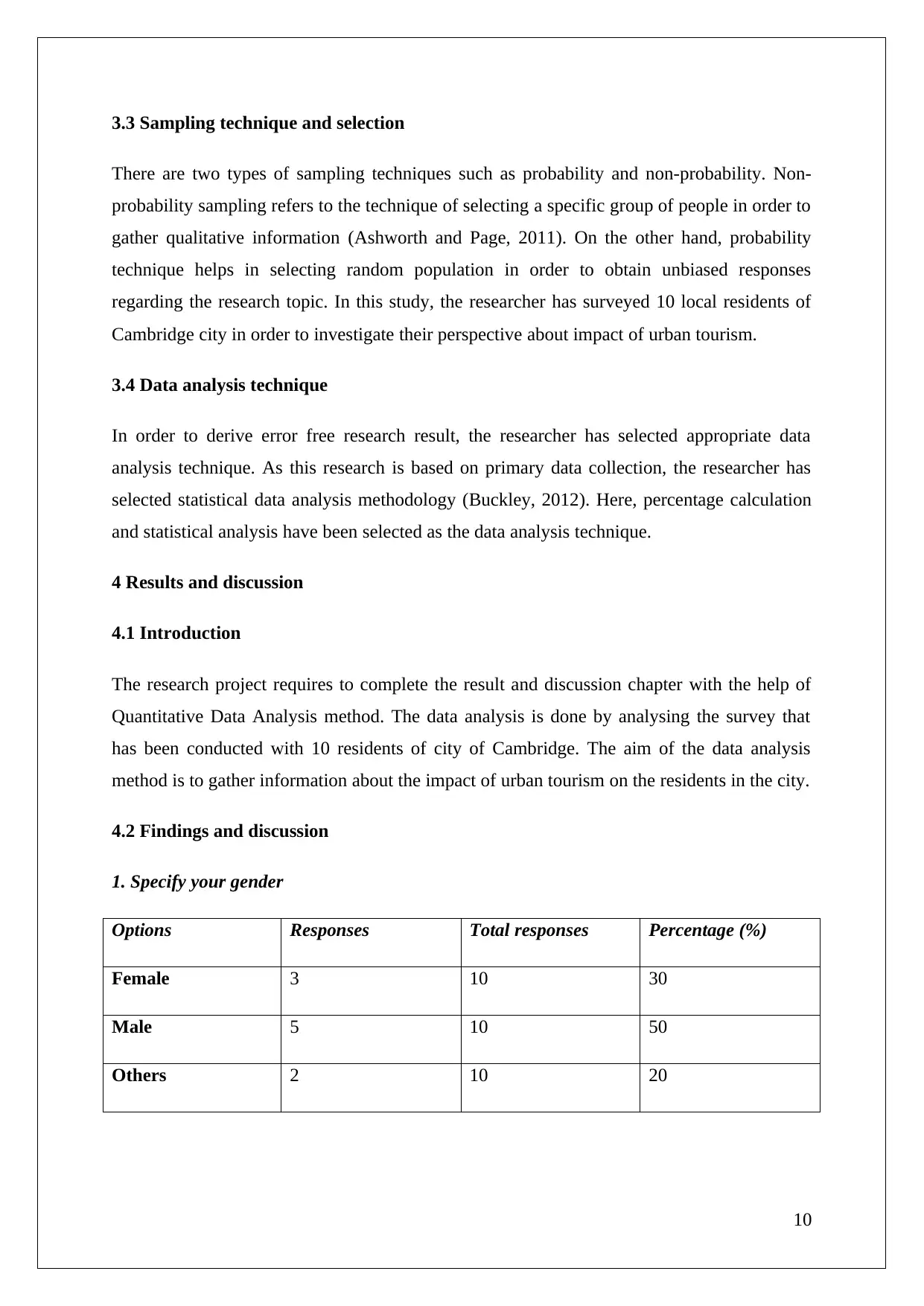
3.3 Sampling technique and selection
There are two types of sampling techniques such as probability and non-probability. Non-
probability sampling refers to the technique of selecting a specific group of people in order to
gather qualitative information (Ashworth and Page, 2011). On the other hand, probability
technique helps in selecting random population in order to obtain unbiased responses
regarding the research topic. In this study, the researcher has surveyed 10 local residents of
Cambridge city in order to investigate their perspective about impact of urban tourism.
3.4 Data analysis technique
In order to derive error free research result, the researcher has selected appropriate data
analysis technique. As this research is based on primary data collection, the researcher has
selected statistical data analysis methodology (Buckley, 2012). Here, percentage calculation
and statistical analysis have been selected as the data analysis technique.
4 Results and discussion
4.1 Introduction
The research project requires to complete the result and discussion chapter with the help of
Quantitative Data Analysis method. The data analysis is done by analysing the survey that
has been conducted with 10 residents of city of Cambridge. The aim of the data analysis
method is to gather information about the impact of urban tourism on the residents in the city.
4.2 Findings and discussion
1. Specify your gender
Options Responses Total responses Percentage (%)
Female 3 10 30
Male 5 10 50
Others 2 10 20
10
There are two types of sampling techniques such as probability and non-probability. Non-
probability sampling refers to the technique of selecting a specific group of people in order to
gather qualitative information (Ashworth and Page, 2011). On the other hand, probability
technique helps in selecting random population in order to obtain unbiased responses
regarding the research topic. In this study, the researcher has surveyed 10 local residents of
Cambridge city in order to investigate their perspective about impact of urban tourism.
3.4 Data analysis technique
In order to derive error free research result, the researcher has selected appropriate data
analysis technique. As this research is based on primary data collection, the researcher has
selected statistical data analysis methodology (Buckley, 2012). Here, percentage calculation
and statistical analysis have been selected as the data analysis technique.
4 Results and discussion
4.1 Introduction
The research project requires to complete the result and discussion chapter with the help of
Quantitative Data Analysis method. The data analysis is done by analysing the survey that
has been conducted with 10 residents of city of Cambridge. The aim of the data analysis
method is to gather information about the impact of urban tourism on the residents in the city.
4.2 Findings and discussion
1. Specify your gender
Options Responses Total responses Percentage (%)
Female 3 10 30
Male 5 10 50
Others 2 10 20
10
Paraphrase This Document
Need a fresh take? Get an instant paraphrase of this document with our AI Paraphraser
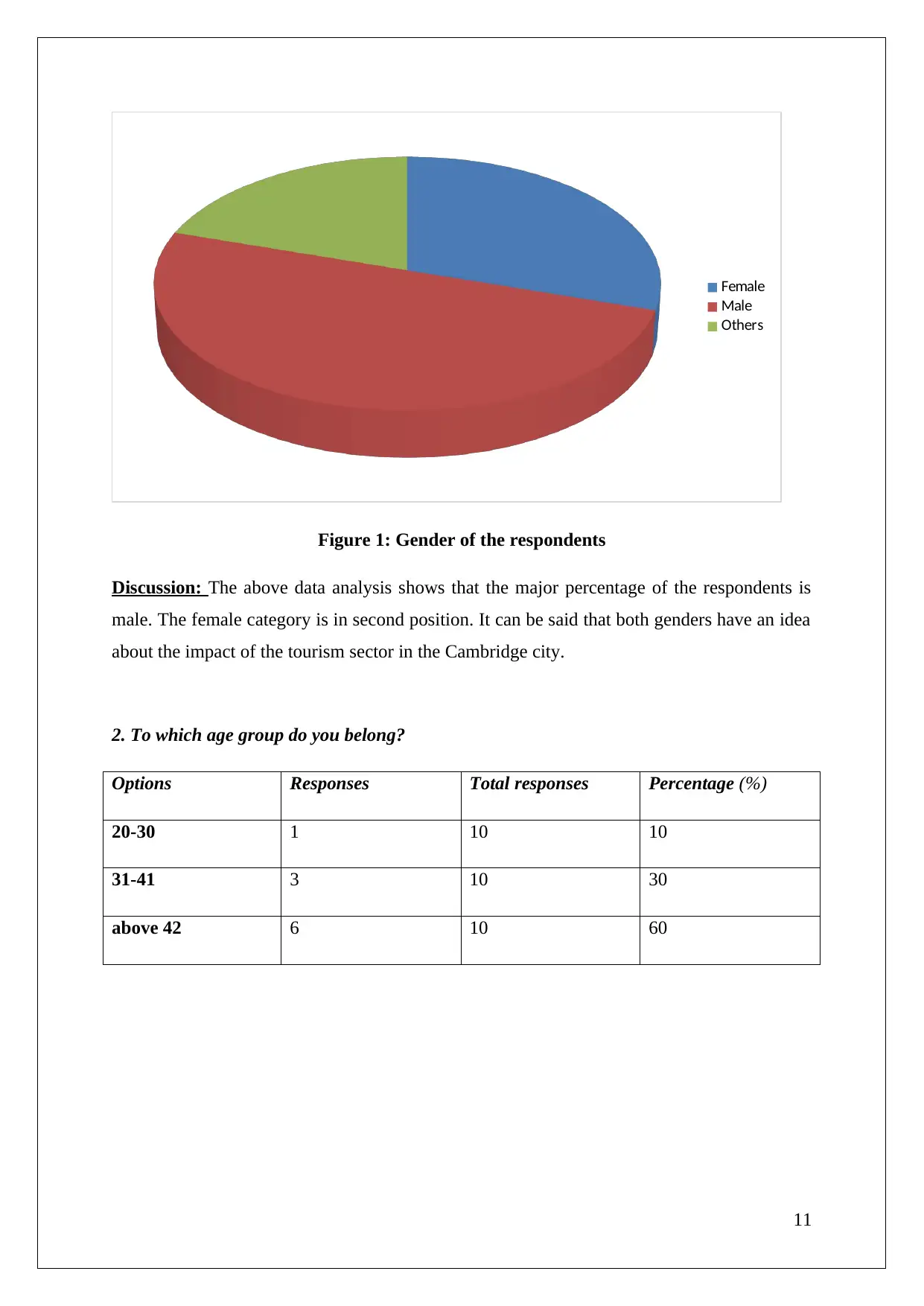
Female
Male
Others
Figure 1: Gender of the respondents
Discussion: The above data analysis shows that the major percentage of the respondents is
male. The female category is in second position. It can be said that both genders have an idea
about the impact of the tourism sector in the Cambridge city.
2. To which age group do you belong?
Options Responses Total responses Percentage (%)
20-30 1 10 10
31-41 3 10 30
above 42 6 10 60
11
Male
Others
Figure 1: Gender of the respondents
Discussion: The above data analysis shows that the major percentage of the respondents is
male. The female category is in second position. It can be said that both genders have an idea
about the impact of the tourism sector in the Cambridge city.
2. To which age group do you belong?
Options Responses Total responses Percentage (%)
20-30 1 10 10
31-41 3 10 30
above 42 6 10 60
11
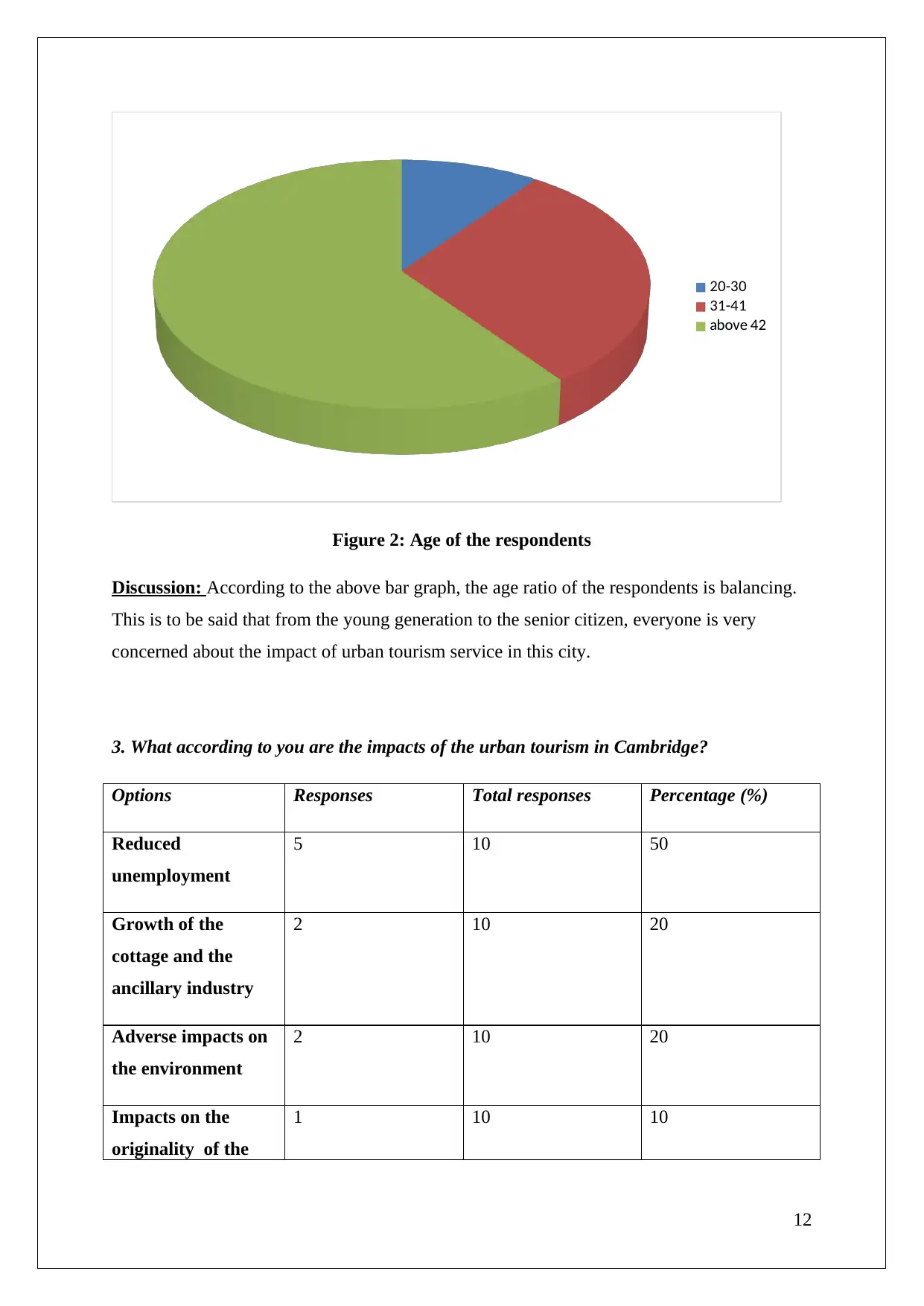
20-30
31-41
above 42
Figure 2: Age of the respondents
Discussion: According to the above bar graph, the age ratio of the respondents is balancing.
This is to be said that from the young generation to the senior citizen, everyone is very
concerned about the impact of urban tourism service in this city.
3. What according to you are the impacts of the urban tourism in Cambridge?
Options Responses Total responses Percentage (%)
Reduced
unemployment
5 10 50
Growth of the
cottage and the
ancillary industry
2 10 20
Adverse impacts on
the environment
2 10 20
Impacts on the
originality of the
1 10 10
12
31-41
above 42
Figure 2: Age of the respondents
Discussion: According to the above bar graph, the age ratio of the respondents is balancing.
This is to be said that from the young generation to the senior citizen, everyone is very
concerned about the impact of urban tourism service in this city.
3. What according to you are the impacts of the urban tourism in Cambridge?
Options Responses Total responses Percentage (%)
Reduced
unemployment
5 10 50
Growth of the
cottage and the
ancillary industry
2 10 20
Adverse impacts on
the environment
2 10 20
Impacts on the
originality of the
1 10 10
12
⊘ This is a preview!⊘
Do you want full access?
Subscribe today to unlock all pages.

Trusted by 1+ million students worldwide
1 out of 28
Related Documents
Your All-in-One AI-Powered Toolkit for Academic Success.
+13062052269
info@desklib.com
Available 24*7 on WhatsApp / Email
![[object Object]](/_next/static/media/star-bottom.7253800d.svg)
Unlock your academic potential
Copyright © 2020–2025 A2Z Services. All Rights Reserved. Developed and managed by ZUCOL.





